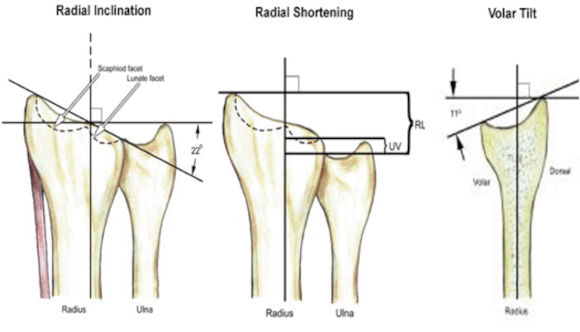An in-depth review of Distal Radius Fractures.
If you're interested in orthopedics, you'll definitely want to check this review out.

Distal radius (DR) fractures have a bimodal age distribution. "accounting for around 25% of fractures in the pediatric population and up to 18% of all fractures in the elderly age group." (2)
The distal radius articulates with the distal ulna, scaphoid, and lunate. The capitate is in the second carpal row and therefore does not articulate with the radius.

Median nerve neuropathy may also occur during immobilization. It can be prevented by avoiding immobilization in excessive wrist flexion and ulnar deviation.
Normal distal radius measurements:
Radial Inclination: 23°
Radial Height (shortening): 12 mm
Volar tilt: 11°

LaFontaines Predictors of Instability.
Patients with 3 or more of the following have a high chance of loss of reduction:
Initial radial shortening > 5 mm (✯)
Dorsal angulation > 20 °
Dorsal Comminution > 50%
Associated Ulna fx
Severe Osteoporosis
✯ Most Important
The Frykmann classification system.
Even numbers are the previous fracture type with an associated ulnar styloid fracture.
1: Extra-articular
3: Intraarticular involving radiocarpal joint
5: IA involving the DRUJ
7: IA involving both the radiocarpal joint and DRUJ

Which type of fracture is shown below?
a) Smith's Fracture
b) Colle's Fracture
c) Barton's Fracture
d) Chauffer's Fracture

The radiograph is demonstrating a Colle's Fracture, it is extra-articular and dorsally displaced. A Smith's fracture is EA and volarly displaced.
A Chauferr's fx is a radial styolid fx.
A Barton's fx is fracture-dislocation of either the volar or dorsal lip of the radius.

Treatment methods:
Non-operative treatment
ORIF with Volar or Dorsal Plating
Closed reduction with percutaneous pinning
Operative Indications:
> 5 mm shortening
> 5° dorsal angulation
> 2 mm articular step off
Volar plating is preferred over dorsal plating. The volar approach to the distal radius is through a Volar Henry or Modified Volar Henry approach.
VH: an interval is made between the brachioradialis and radial artery
MVH: an interval is made between the FCR and radial artery

Complications:
Median nerve neuropathy
Radiocarpal Arthritis
EPL and FPL rupture
Ulnar nerve neuropathy (DRUJ injury)
References:
1: https://www.ncbi.nlm.nih.gov/books/NBK536916/
2: https://www.ncbi.nlm.nih.gov/pmc/articles/PMC3345129/
3: https://www.ncbi.nlm.nih.gov/pmc/articles/PMC6255731/
Full Review and Conversation on X